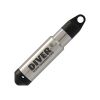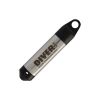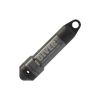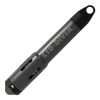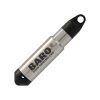Van Essen Diver-Mate Data Download Unit
Features
- Supplied with 16 GB memory card
- Built-in battery, rechargeable through USB-C
- Works seamlessly with new Diver-App
- Free ground shipping
- Expedited repair and warranty service
- Lifetime technical support
- More
Overview
The Van Essen Diver-Mate Data Download Unit is designed for simple and fast download of Diver groundwater data logger data, increasing download efficiency while reducing data transfer errors. A Diver DXT-Cable is used for connecting it to the Diver. Equipped with Bluetooth, it offers a wealth of possibilities for forwarding data, cloud storage and assessing the status of the well. The Diver-Mate also shows the DXT Cable signal quality and the Diver data download progress if Diver and cable are working correctly.
Data Collection
With 16 GB non-volatile memory drive, the Diver-Mate has more than sufficient capacity to store the data of thousands of Divers. Connect the Diver-Mate to a laptop using the supplied USB-C cable. The collected field data can easily be imported by Diver-Office for further processing. The files on the Diver-Mate can also be accessed through Windows File Explorer like any USB flash drive.
| Dimensions | 79 mm × 132 mm × 24 mm (W×L×H) |
| Weight | ~152 grams |
| Protection Classification | IP41 |
| Memory | 16 GB |
| Battery | Rechargeable Lithium Polymer |
| Battery Life | 10 days (single charge, dependent on usage) |
| Barometric Pressure Sensor | 400 to 1100 cmH2O |
In The News
Three Decades of Research at Acton Lake
A multi-disciplinary team at Miami University, Ohio, has been studying the environmental change at Acton Lake for over three decades. Using three different NexSens buoys over this time, the team has an incredible archive of data that is helping build a picture of Acton’s past, present, and future. Until recently, a NexSens CB-50 buoy was used alongside other environmental monitoring at Acton Lake. In May 2025, the Miami team deployed a new XB-200 buoy , future-proofing their ongoing monitoring using real-time buoy systems. Acton Lake, a small hypereutrophic reservoir in southwest Ohio, covers 2.4km² and has a maximum depth of about 8m. The dam was built in 1956, and the lake has a large agricultural watershed.
Read MoreSource Water Monitoring in Albany, New York: Tracing Water Quality throughout Tributaries
Thousands of US cities pull their drinking water from natural source waters like reservoirs, rivers, and streams, making overall watershed health a key consideration for water providers. In Albany, New York, the Albany Department of Water and Water Supply delivers drinking water to over 100,000 residents as well as monitors and manages the larger drinking water supply watershed. Hannah Doherty, Environmental Specialist at the Albany Department of Water and Water Supply , spends her days working with a small team to monitor the drinking supply and the connected water bodies. Doherty explains, “We’re the first to encounter the water that ends up being the drinking water.
Read MoreWildfire Prevention in the Sierra Nevada Region with the Yuba Watershed Institute
Though recent wildfires have sparked new conversations about wildfire management and response, groups like the Yuba Watershed Institute have been monitoring the forests and water resources of the Sierra Nevada region for decades, managing approximately 5,000 acres of land with the Bureau of Land Management (BLM) and about 7,000 acres in private land partnerships. The goal of the Institute is to work with local communities and land agencies to improve watershed and forestry management through informed practices and public outreach. The goals of the Yuba Watershed Institute are three-fold: Improve the ability of fire suppression agencies like the California Department of Forestry and Fire Protection ( CAL FIRE ) and the US Forest Service.
Read More





















